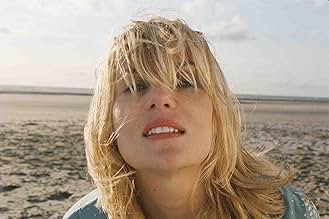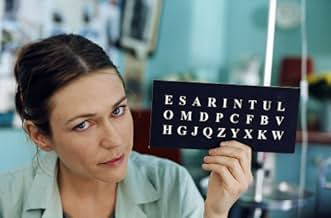La vera storia di Jean-Dominique Bauby, giornalista che nel '95, in seguito ad un incidente, finisce in coma. Quando ne esce l'unico movimento che gli è consentito è quello di una delle palp... Leggi tuttoLa vera storia di Jean-Dominique Bauby, giornalista che nel '95, in seguito ad un incidente, finisce in coma. Quando ne esce l'unico movimento che gli è consentito è quello di una delle palpebre, con la quale riesce a comunicare ed a scrivere un libro 'Lo scafandro e la farfalla'... Leggi tuttoLa vera storia di Jean-Dominique Bauby, giornalista che nel '95, in seguito ad un incidente, finisce in coma. Quando ne esce l'unico movimento che gli è consentito è quello di una delle palpebre, con la quale riesce a comunicare ed a scrivere un libro 'Lo scafandro e la farfalla'.
- Regia
- Sceneggiatura
- Star
- Candidato a 4 Oscar
- 68 vittorie e 107 candidature totali
Recensioni in evidenza
American born director Julian Schnabel picked up the memoir and made it into a movie that will re-examine the way a person will view his life. From the way the movie was presented to the audience, it might seems to be difficult to digest, but if you watch them once again, you will find that the flow of the movie follows closely to what is written on the book.
The story begins with Jean Dominique (Mathieu Amalric) finding himself woke up in a hospital,unable to move his body. Upon hearing from the doctor that a stroke left him unable to move, except his left eye, he found himself trapped in a prison: his body. He describes his body as a diving bell, where death sentence prisoner would wore the diving bell and drowned in the sea. With doctors and therapists taking care of him, he found himself living without dignity.
With the help of Henriteet (Marie Jozee Croze), a speech therapist, she uses a unique method of communicating with Jean thru pronouncing the alphabets and Jean would form a word or sentence by blinking the eye. After getting to know her much more better, Jean found his way to survive thru the disabilities: imagination and beautiful memories. Both set his spirit free, and he feels like he is flying like a butterfly. And thus he began writing his memoirs of his life.
The story is told through the view from Jean's left eye and reaction in his mind after the stroke. This pulls the audience and the inner world of Jean closer, and audience could have a feel of putting themselves into Jean's shoes. From the effort the cast and crew puts in the movie, we can tell that the movie is follow everything accordingly to the book, without any adjustments.
The Diving Bell and the Butterfly is the movie that you need if you want to take a break from normal popcorn flicks, or a movie that makes you think through about yourself, and how you live life to the fullest.
Beautifully shot by cinematographer Janusz Kaminski with a screenplay by Ronald Harwood, the film begins with Bauby's confused awakening in the hospital after twenty days in a coma. We see only a blur of images and claustrophobic close-ups that mirror the patient's mental state. We can make out a hospital room and doctors and nurses offering reassuring thoughts. We hear Bauby's words but the doctors do not and we know that while his body isn't functioning, his mind is as sharp as ever. With the help of a speech therapist (Marie-Josée Croze), and a very patient transcriber, a code is developed that allows Bauby (Mathieu Amalric), called Jean-Do by his friends and family, to compose a book based on his experience.
When the therapist recites the most-frequently used letters in the French alphabet, Bauby blinks when he wants to choose a letter. The book, on which the film is based, was published in 1997, shortly after Bauby's death. One of the most dramatic moments in the film occurs near the beginning when the first thought Jean-Do communicates is that he wants to die. Feeling rejected and angry, the therapist stomps out of the room but apologizes and comes back shortly to resume the treatment. We do not actually see Jean-Do until about a third of the way through the film but we can hear his thoughts which are in turn angry, funny, and bitterly ironic. Bauby compares his body to a deep-sea diver being suffocated in a diving suit and his poetic imagination to a butterfly.
It is Jean-Do's sense of humor that keeps the film as light as it can be under the circumstances and his eloquence that keeps us riveted. When we finally do see him with his immobile body and his drooping lower lip, it is still a shock but we smile when he says that "I look like I came out of a vat of formaldehyde." Much of the film vividly explores the editor's imagination and the camera takes us on some wild rides that include images of Nijinsky, Empress Eugénie, Marlon Brando, and Jean-Do in his imagination skiing and surfing. Some of the most emotional moments occur when he greets his young children at the beach for the first time after his stroke, a telephone "conversation" with his 92-year old father (Max Von Sydow), and flashbacks to his youth - driving with his girlfriend, shaving his father, supervising a fashion shoot, and taking his son on a trip in a new sports car. Bauby's wife Céline (Emmanuelle Seigner), whom he left for exotic girlfriend Ines (Agathe de La Fontaine), visits him in the hospital and comforts him while Ines cannot bring herself to see him, saying that she wants to remember him the way he was.
Realizing how his life had been less than exemplary, his stroke becomes an opportunity for redemption and allows him, if not to cleanse his soul, to discover that humanity lies in his consciousness not in material things or sexuality. The Diving Bell and the Butterfly is a film of enormous power that shakes us and enables us to get in touch with the miracle of each moment. Schnabel says that his purpose in making the film was to tell "the story of all of us, who surely do face death and sickness. But if we look", he says, "we can find meaning and beauty here." There is enough of both meaning and beauty to make The Diving Bell and the Butterfly one of the best films of the year.
This is an anti-Hollywood, anti-formula movie. Those have their place, but this is a great antidote to the silly decisions made by inappropriately powerful studio execs.
See it. You'll be thankful you did.
The film deals with a rare physical condition, and I was physically there with the character from start to finish. I felt each moment as if it were my own. That is a rare accomplishment in cinema. Julian Schnabel directed a stellar cast. Mathieu Amalric was unusually charming as Jean-Dominique Bauby, and Max Von Sydow was heartbreaking as his lonely widower father. The female leads were all equally impressive as they were beautiful. I don not mean to generalize them, but they were all so excellent that they blend seamlessly in my mind, in terms of performance.
Overall, this film was as pure a cinematic experience as I've witnessed in a long time. A true artist turns out a film that is truly a piece of art. Julian Schnabel takes his time in between films, but with work like this, there's no need to rush. Like a good painting, one can enjoy it for a lifetime.
Saying more about the plot would spoil the wonderful experience of watching "The Diving Bell and the Butterfly". The camera angles/visuals are breathtaking (courtesy of two-time Oscar winning cinematographer Janusz Kaminski), and in some moments he makes us see everything from Bauby's point of view. In spite of Bauby's disability, the film is never overly melodramatic, being similar to (but even better than) "The Sea Inside" and "My Left Foot". The cast is fantastic, from Amalric to screen legend Max von Sydow, and the beautiful women in Jean-Do's life (Marie-Josée Croze, Anne Consigny and Emmanuelle Seigner, among others). The soundtrack is also memorable, including Charles Trenet's wondrous "La Mer" (which was recorded by Bobby Darin in English as "Beyond the Sea"). "The Diving Bell and the Butterfly" won the Golden Globes for best director and foreign film, and got four Oscar nominations (director, adapted screenplay, editing and cinematography - but NOT Best Foreign Film). France made the mistake of submitting the (fantastic) animation "Persepolis" instead of "Diving Bell", but they should know the Academy would never give Best Foreign Film for an animated movie, as good as it might be, and therefore neither of them got the nomination. But that's actually the Academy's fault for their stupid rules, since France should've been allowed to submit both movies. What if two of the best foreign movies of the year were from the same country? In a perfect world, there would be only a Best Picture category and films from any country and any language would be nominated, but since most people still ignore subtitles, this 'segregation' has to exist. Oh well. Oscar blunders apart, this is a film that will make you see and value the beauty of life. Bravo, Mr. Schnabel! Bravo, Monsieur Bauby! 10/10.
Lo sapevi?
- QuizTo familiarize himself with Bauby's sheltered existence, director Julian Schnabel made the movie in the same hospital where Bauby was treated, meeting many of the orderlies who had treated him. He also shot scenes on the same balcony where Bauby relaxed, and on the same nearby beach to which his family had taken him.
- BlooperWhen Jean-Dominique goes on a boat ride, a 'Speedferries' vessel can be seen in the background. Speedferries started business in 2004, years after the movie was set.
- Citazioni
Jean-Dominique Bauby: I decided to stop pitying myself. Other than my eye, two things aren't paralyzed, my imagination and my memory.
- Colonne sonoreTheme for The Diving-Bell and the Butterfly
Composed by Paul Cantelon
Studio recording The University of Victoria
Engineer / Producer Russell Dawkin
I più visti
Dettagli
- Data di uscita
- Paesi di origine
- Sito ufficiale
- Lingua
- Celebre anche come
- El llanto de la mariposa
- Luoghi delle riprese
- Aziende produttrici
- Vedi altri crediti dell’azienda su IMDbPro
Botteghino
- Lordo Stati Uniti e Canada
- 6.003.227 USD
- Fine settimana di apertura Stati Uniti e Canada
- 75.721 USD
- 2 dic 2007
- Lordo in tutto il mondo
- 19.780.116 USD
- Tempo di esecuzione1 ora 52 minuti
- Colore
- Mix di suoni
- Proporzioni
- 1.85 : 1
Contribuisci a questa pagina









































